|
SNAP Library 2.0, Developer Reference
2013-05-13 16:33:57
SNAP, a general purpose, high performance system for analysis and manipulation of large networks
|
|
SNAP Library 2.0, Developer Reference
2013-05-13 16:33:57
SNAP, a general purpose, high performance system for analysis and manipulation of large networks
|
#include <cliques.h>
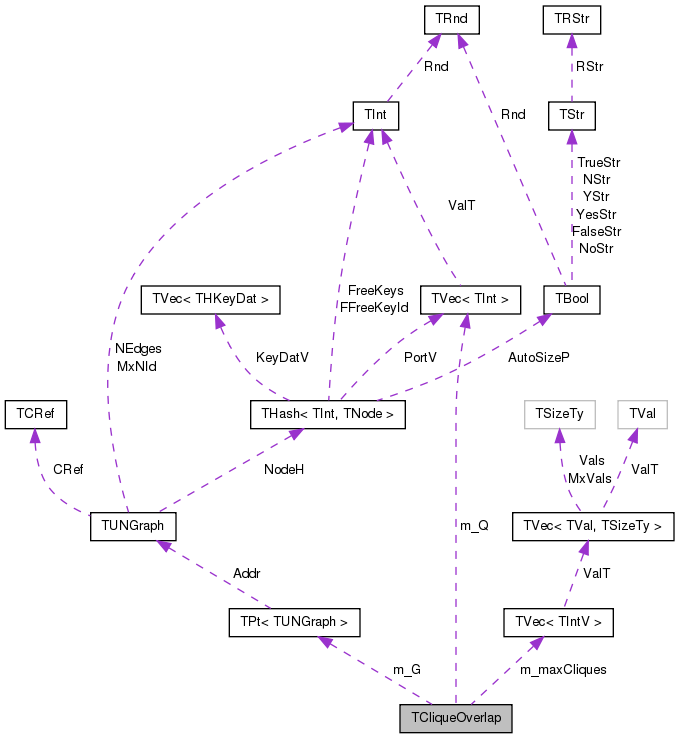
Public Member Functions | |
| TCliqueOverlap () | |
| void | GetMaximalCliques (const PUNGraph &G, int MinMaxCliqueSize, TVec< TIntV > &MaxCliques) |
Static Public Member Functions | |
| static void | GetRelativeComplement (const THashSet< TInt > &A, const THashSet< TInt > &B, THashSet< TInt > &Complement) |
| static void | GetIntersection (const THashSet< TInt > &A, const THashSet< TInt > &B, THashSet< TInt > &C) |
| static int | Intersection (const THashSet< TInt > &A, const THashSet< TInt > &B) |
| static void | CalculateOverlapMtx (const TVec< TIntV > &MaxCliques, int MinNodeOverlap, TVec< TIntV > &OverlapMtx) |
| static PUNGraph | CalculateOverlapMtx (const TVec< TIntV > &MaxCliques, int MinNodeOverlap) |
| static void | GetOverlapCliques (const TVec< TIntV > &OverlapMtx, int MinNodeOverlap, TVec< TIntV > &CliqueIdVV) |
| static void | GetOverlapCliques (const TVec< TIntV > &OverlapMtx, const TVec< TIntV > &MaxCliques, double MinOverlapFrac, TVec< TIntV > &CliqueIdVV) |
| static void | GetMaxCliques (const PUNGraph &G, int MinMaxCliqueSize, TVec< TIntV > &MaxCliques) |
| Enumerate maximal cliques of the network on more than MinMaxCliqueSize nodes. | |
| static void | GetCPMCommunities (const PUNGraph &G, int MinMaxCliqueSize, TVec< TIntV > &Communities) |
| Clique Percolation method communities. | |
Private Member Functions | |
| void | GetNbrs (int NId, THashSet< TInt > &Nbrs) const |
| int | GetNodeIdWithMaxDeg (const THashSet< TInt > &Set) const |
| int | MaxNbrsInCANDNodeId (const THashSet< TInt > &SUBG, const THashSet< TInt > &CAND) const |
| void | Expand (const THashSet< TInt > &SUBG, THashSet< TInt > &CAND) |
Private Attributes | |
| PUNGraph | m_G |
| TIntV | m_Q |
| TVec< TIntV > * | m_maxCliques |
| int | m_minMaxCliqueSize |
| TCliqueOverlap::TCliqueOverlap | ( | ) | [inline] |
Definition at line 29 of file cliques.h.
: m_G(), m_Q(), m_maxCliques(NULL), m_minMaxCliqueSize(3) { }
| void TCliqueOverlap::CalculateOverlapMtx | ( | const TVec< TIntV > & | MaxCliques, |
| int | MinNodeOverlap, | ||
| TVec< TIntV > & | OverlapMtx | ||
| ) | [static] |
Definition at line 127 of file cliques.cpp.
References TVec< TVal, TSizeTy >::Add(), TVec< TVal, TSizeTy >::Clr(), TVec< TVal, TSizeTy >::Gen(), Intersection(), TVec< TVal, TSizeTy >::Last(), and TVec< TVal, TSizeTy >::Len().
Referenced by GetCPMCommunities().
{
OverlapMtx.Clr();
//
int n = MaxCliques.Len();
//Convert max cliques to HashSets
TVec<THashSet<TInt> > cliques;
for (int i=0; i<n; i++) {
const int len = MaxCliques[i].Len();
cliques.Add();
if (len < MinNodeOverlap) { continue; }
THashSet<TInt>& set = cliques.Last(); set.Gen(len);
for (int j=0; j<len; j++) { set.AddKey(MaxCliques[i][j]); }
}
//Init clique clique overlap matrix
n = cliques.Len();
OverlapMtx.Gen(n);
for (int i=0; i<n; i++) OverlapMtx[i].Gen(n);
//Calculate clique clique overlap matrix
for (int i=0; i<n; i++) {
OverlapMtx[i][i] = cliques[i].Len();
for (int j=i+1; j<n; j++) {
OverlapMtx[i][j] = Intersection(cliques[i], cliques[j]); }
}
}
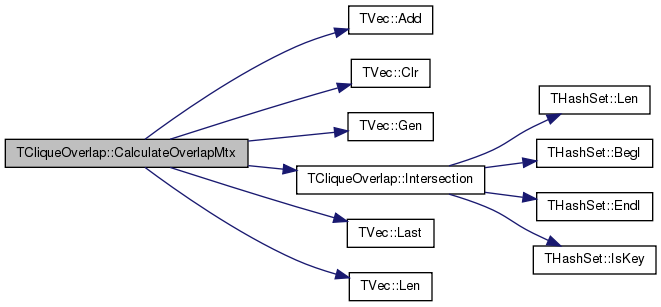

| PUNGraph TCliqueOverlap::CalculateOverlapMtx | ( | const TVec< TIntV > & | MaxCliques, |
| int | MinNodeOverlap | ||
| ) | [static] |
Definition at line 152 of file cliques.cpp.
References TVec< TVal, TSizeTy >::Add(), TUNGraph::AddEdge(), TUNGraph::AddNode(), Intersection(), TVec< TVal, TSizeTy >::Last(), TVec< TVal, TSizeTy >::Len(), and TUNGraph::New().
{
const int n = MaxCliques.Len();
//Convert max cliques to HashSets
TVec<THashSet<TInt> > cliques;
for (int i=0; i<n; i++) {
const int len = MaxCliques[i].Len();
cliques.Add();
if (len < MinNodeOverlap) { continue; }
THashSet<TInt>& set = cliques.Last(); set.Gen(len);
for (int j=0; j<len; j++) { set.AddKey(MaxCliques[i][j]); }
}
//Init clique clique overlap matrix
PUNGraph OverlapMtx = TUNGraph::New();
for (int i=0; i < n; i++) {
OverlapMtx->AddNode(i); }
//Calculate clique clique overlap matrix
for (int i=0; i<n; i++) {
for (int j=i+1; j<n; j++) {
if (Intersection(cliques[i], cliques[j]) >= MinNodeOverlap) {
OverlapMtx->AddEdge(i,j); }
}
}
return OverlapMtx;
}
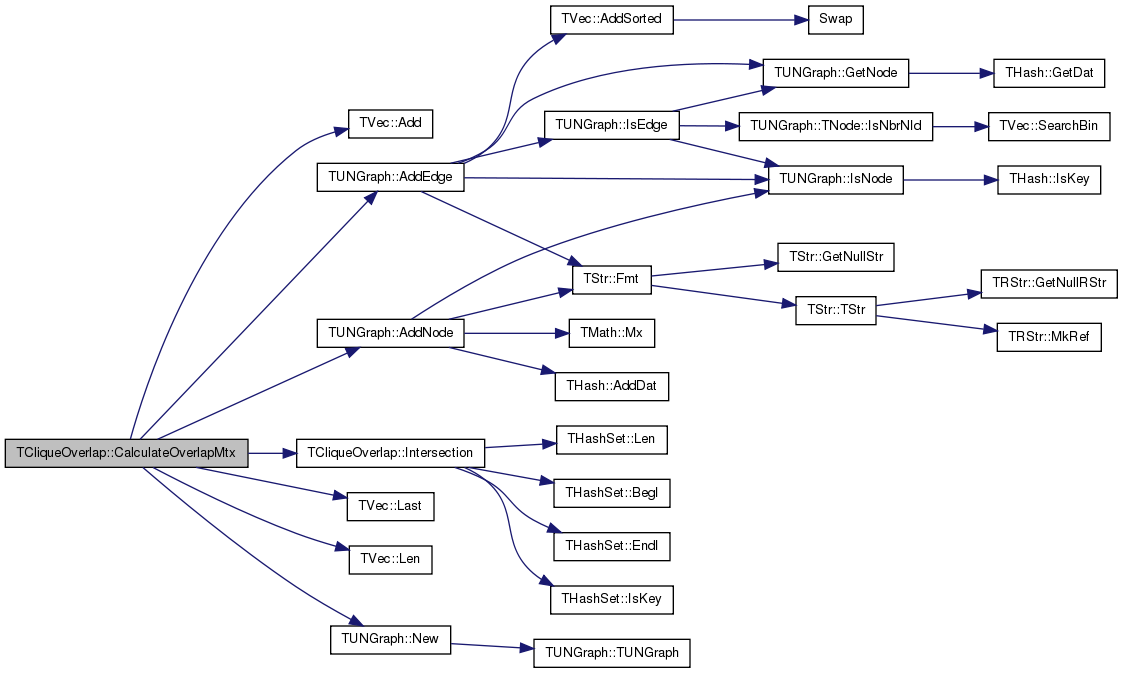
| void TCliqueOverlap::Expand | ( | const THashSet< TInt > & | SUBG, |
| THashSet< TInt > & | CAND | ||
| ) | [private] |
Definition at line 73 of file cliques.cpp.
References TVec< TVal, TSizeTy >::Add(), THashSet< TKey, THashFunc >::Clr(), THashSet< TKey, THashFunc >::DelKey(), TVec< TVal, TSizeTy >::DelLast(), GetIntersection(), GetNbrs(), GetNodeIdWithMaxDeg(), GetRelativeComplement(), TVec< TVal, TSizeTy >::Len(), THashSet< TKey, THashFunc >::Len(), m_maxCliques, m_minMaxCliqueSize, m_Q, MaxNbrsInCANDNodeId(), and TVec< TVal, TSizeTy >::Pack().
Referenced by GetMaximalCliques().
{
if (SUBG.Len()==0) { if (m_Q.Len() >= m_minMaxCliqueSize) { m_Q.Pack(); m_maxCliques->Add(m_Q); } return; }
if (CAND.Len()==0) return;
//Get u that maximaze CAND intersection with neighbours of vertex u
int u = MaxNbrsInCANDNodeId(SUBG, CAND);
//Get neighbours of node u
THashSet<TInt> nbrsU;
GetNbrs(u, nbrsU);
//Get relative complement of nbrsU in CAND
THashSet<TInt> EXT;
GetRelativeComplement(CAND, nbrsU, EXT);
while(EXT.Len() != 0) {
int q = GetNodeIdWithMaxDeg(EXT);
//
m_Q.Add(q);
//
THashSet<TInt> nbrsQ;
GetNbrs(q, nbrsQ);
//
THashSet<TInt> SUBGq;
GetIntersection(SUBG, nbrsQ, SUBGq);
//
THashSet<TInt> CANDq;
GetIntersection(CAND, nbrsQ, CANDq);
//
Expand(SUBGq, CANDq);
//
CAND.DelKey(q);
m_Q.DelLast();
//
EXT.Clr();
GetRelativeComplement(CAND, nbrsU, EXT);
}
}
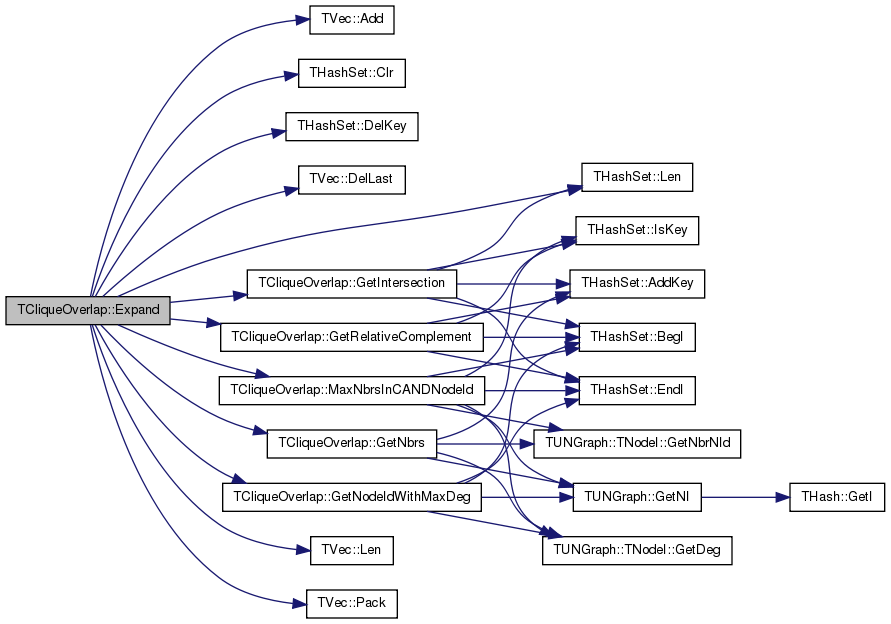

| void TCliqueOverlap::GetCPMCommunities | ( | const PUNGraph & | G, |
| int | MinMaxCliqueSize, | ||
| TVec< TIntV > & | Communities | ||
| ) | [static] |
Clique Percolation method communities.
Definition at line 224 of file cliques.cpp.
References TVec< TVal, TSizeTy >::Add(), THashSet< TKey, THashFunc >::AddKeyV(), CalculateOverlapMtx(), TVec< TVal, TSizeTy >::Clr(), THashSet< TKey, THashFunc >::Clr(), TUNGraph::GetEdges(), THashSet< TKey, THashFunc >::GetKeyV(), GetMaxCliques(), TUNGraph::GetNodes(), TExeTm::GetStr(), TSnap::GetWccs(), TVec< TVal, TSizeTy >::Last(), and TVec< TVal, TSizeTy >::Sort().
{
printf("Clique Percolation Method\n");
TExeTm ExeTm;
TVec<TIntV> MaxCliques;
TCliqueOverlap::GetMaxCliques(G, MinMaxCliqueSize, MaxCliques);
// op RS 2012/05/15, commented out next line, a parameter is missing,
// creating a warning on OS X
// printf("...%d cliques found\n");
// get clique overlap matrix (graph)
PUNGraph OverlapGraph = TCliqueOverlap::CalculateOverlapMtx(MaxCliques, MinMaxCliqueSize-1);
printf("...overlap matrix (%d, %d)\n", G->GetNodes(), G->GetEdges());
// connected components are communities
TCnComV CnComV;
TSnap::GetWccs(OverlapGraph, CnComV);
NIdCmtyVV.Clr(false);
TIntSet CmtySet;
for (int c = 0; c < CnComV.Len(); c++) {
CmtySet.Clr(false);
for (int i = 0; i <CnComV[c].Len(); i++) {
const TIntV& CliqueNIdV = MaxCliques[CnComV[c][i]];
CmtySet.AddKeyV(CliqueNIdV);
}
NIdCmtyVV.Add();
CmtySet.GetKeyV(NIdCmtyVV.Last());
NIdCmtyVV.Last().Sort();
}
printf("done [%s].\n", ExeTm.GetStr());
}
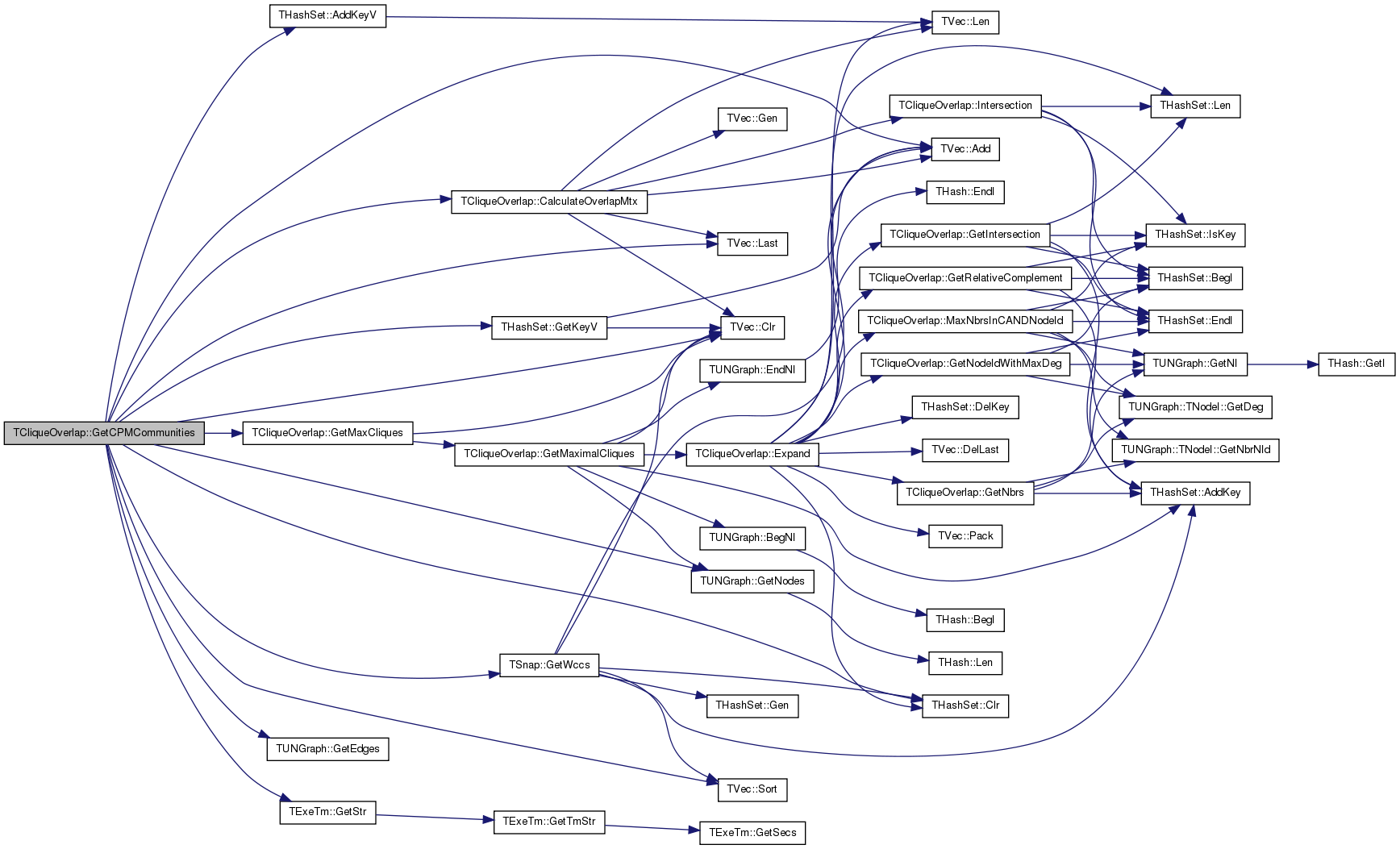
| void TCliqueOverlap::GetIntersection | ( | const THashSet< TInt > & | A, |
| const THashSet< TInt > & | B, | ||
| THashSet< TInt > & | C | ||
| ) | [static] |
Definition at line 13 of file cliques.cpp.
References THashSet< TKey, THashFunc >::AddKey(), THashSet< TKey, THashFunc >::BegI(), THashSet< TKey, THashFunc >::EndI(), THashSet< TKey, THashFunc >::IsKey(), and THashSet< TKey, THashFunc >::Len().
Referenced by Expand().
{
if (A.Len() < B.Len()) {
for (THashSetKeyI<TInt> it=A.BegI(); it<A.EndI(); it++)
if (B.IsKey(it.GetKey())) C.AddKey(it.GetKey());
} else {
for (THashSetKeyI<TInt> it=B.BegI(); it<B.EndI(); it++)
if (A.IsKey(it.GetKey())) C.AddKey(it.GetKey());
}
}


| void TCliqueOverlap::GetMaxCliques | ( | const PUNGraph & | G, |
| int | MinMaxCliqueSize, | ||
| TVec< TIntV > & | MaxCliques | ||
| ) | [static] |
Enumerate maximal cliques of the network on more than MinMaxCliqueSize nodes.
Definition at line 217 of file cliques.cpp.
References TVec< TVal, TSizeTy >::Clr(), and GetMaximalCliques().
Referenced by GetCPMCommunities().
{
TCliqueOverlap CO;
MaxCliques.Clr(false);
CO.GetMaximalCliques(G, MinMaxCliqueSize, MaxCliques);
}


| void TCliqueOverlap::GetMaximalCliques | ( | const PUNGraph & | G, |
| int | MinMaxCliqueSize, | ||
| TVec< TIntV > & | MaxCliques | ||
| ) |
Definition at line 108 of file cliques.cpp.
References THashSet< TKey, THashFunc >::AddKey(), TUNGraph::BegNI(), TVec< TVal, TSizeTy >::Clr(), TUNGraph::EndNI(), Expand(), TUNGraph::GetNodes(), m_G, m_maxCliques, m_minMaxCliqueSize, and m_Q.
Referenced by GetMaxCliques().
{
if (G->GetNodes() == 0) return;
//
m_G = G;
m_minMaxCliqueSize = MinMaxCliqueSize;
m_maxCliques =& MaxCliques;
m_Q.Clr();
//
THashSet<TInt> SUBG;
THashSet<TInt> CAND;
for (TUNGraph::TNodeI NI=m_G->BegNI(); NI<m_G->EndNI(); NI++) {
TInt nId = NI.GetId();
SUBG.AddKey(nId);
CAND.AddKey(nId);
}
//
Expand(SUBG, CAND);
}
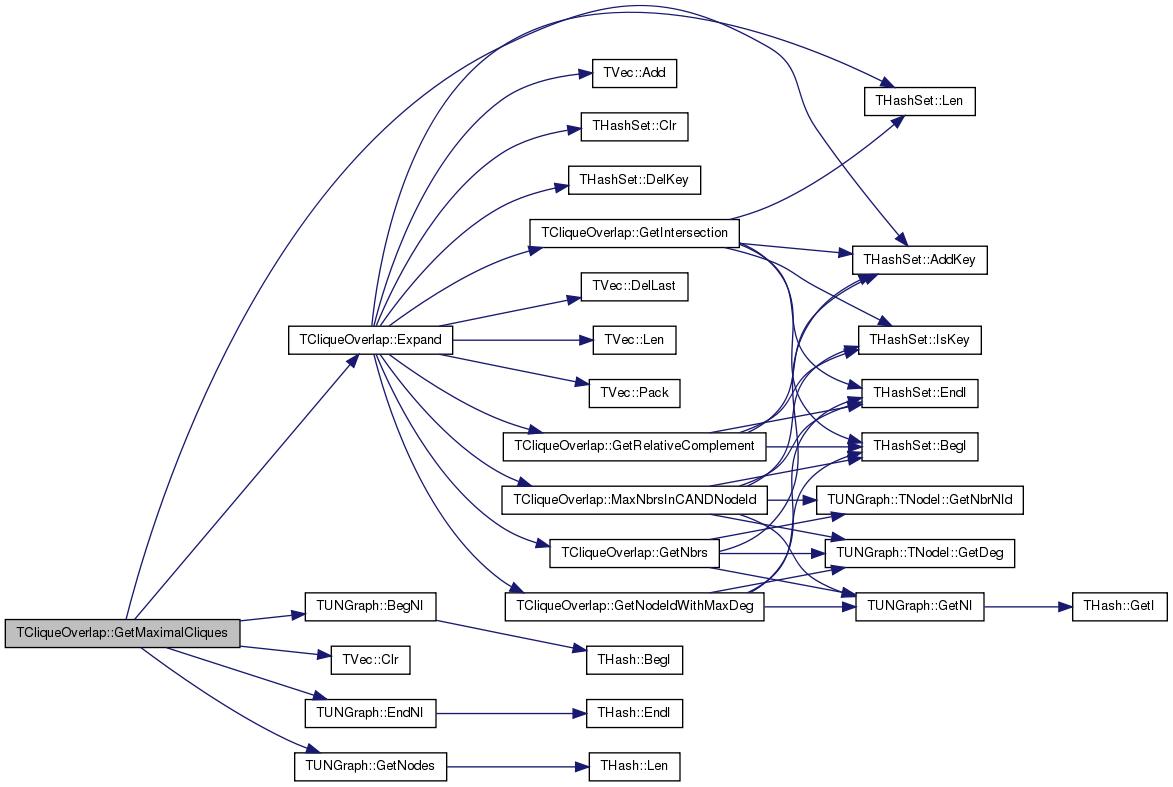

| void TCliqueOverlap::GetNbrs | ( | int | NId, |
| THashSet< TInt > & | Nbrs | ||
| ) | const [private] |
Definition at line 35 of file cliques.cpp.
References THashSet< TKey, THashFunc >::AddKey(), TUNGraph::TNodeI::GetDeg(), TUNGraph::TNodeI::GetNbrNId(), TUNGraph::GetNI(), and m_G.
Referenced by Expand().
{
TUNGraph::TNodeI node = m_G->GetNI(NId);
int deg = node.GetDeg();
for (int i=0; i<deg; i++) Nbrs.AddKey(node.GetNbrNId(i));
}
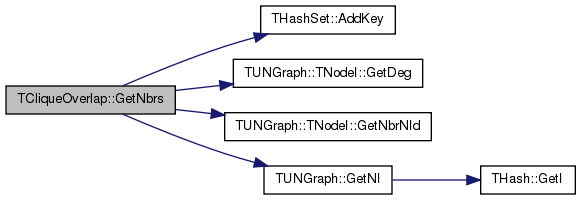

| int TCliqueOverlap::GetNodeIdWithMaxDeg | ( | const THashSet< TInt > & | Set | ) | const [private] |
Definition at line 41 of file cliques.cpp.
References THashSet< TKey, THashFunc >::BegI(), THashSet< TKey, THashFunc >::EndI(), TUNGraph::TNodeI::GetDeg(), TUNGraph::GetNI(), and m_G.
Referenced by Expand().
{
int id = -1;
int maxDeg = -1;
//
for (THashSetKeyI<TInt> it=Set.BegI(); it<Set.EndI(); it++) {
int nId = it.GetKey();
int deg = m_G->GetNI(nId).GetDeg();
if (maxDeg < deg) { maxDeg=deg; id=nId; }
}
return id;
}


| void TCliqueOverlap::GetOverlapCliques | ( | const TVec< TIntV > & | OverlapMtx, |
| int | MinNodeOverlap, | ||
| TVec< TIntV > & | CliqueIdVV | ||
| ) | [static] |
Definition at line 177 of file cliques.cpp.
References TVec< TVal, TSizeTy >::Add(), TVec< TVal, TSizeTy >::Last(), and TVec< TVal, TSizeTy >::Len().
{
int n = OverlapMtx.Len();
for (int i=0; i<n; i++) {
bool isCommunity = false;
for (int j=i+1; j<n; j++) {
if (OverlapMtx[i][j] >= MinNodeOverlap) {
if (! isCommunity) {
TIntV v; v.Add(i);
CliqueIdVV.Add(v);
isCommunity=true;
}
CliqueIdVV.Last().Add(j);
}
}
}
}
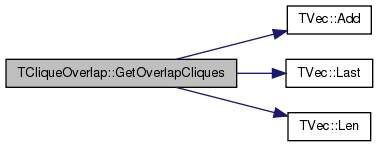
| void TCliqueOverlap::GetOverlapCliques | ( | const TVec< TIntV > & | OverlapMtx, |
| const TVec< TIntV > & | MaxCliques, | ||
| double | MinOverlapFrac, | ||
| TVec< TIntV > & | CliqueIdVV | ||
| ) | [static] |
Definition at line 194 of file cliques.cpp.
References TVec< TVal, TSizeTy >::Add(), TVec< TVal, TSizeTy >::Last(), and TVec< TVal, TSizeTy >::Len().
{
int n = OverlapMtx.Len();
for(int i=0; i<n; i++){
bool isCommunity = false;
int size1 = MaxCliques[i].Len();
for(int j=i+1; j<n; j++){
int size2 = MaxCliques[j].Len();
double ratio = OverlapMtx[i][j];
if(size1 < size2) ratio /= size1;
else ratio /= size2;
if(ratio >= MinOverlapFrac){
if(!isCommunity){
TIntV v; v.Add(i);
CliqueIdVV.Add(v);
isCommunity=true;
}
CliqueIdVV.Last().Add(j);
}
}
}
}
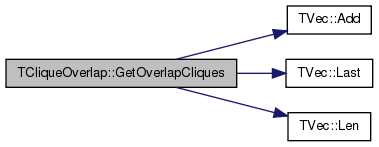
| void TCliqueOverlap::GetRelativeComplement | ( | const THashSet< TInt > & | A, |
| const THashSet< TInt > & | B, | ||
| THashSet< TInt > & | Complement | ||
| ) | [static] |
Definition at line 6 of file cliques.cpp.
References THashSet< TKey, THashFunc >::AddKey(), THashSet< TKey, THashFunc >::BegI(), THashSet< TKey, THashFunc >::EndI(), and THashSet< TKey, THashFunc >::IsKey().
Referenced by Expand().
{
for (THashSet<TInt>::TIter it=A.BegI(); it<A.EndI(); it++) {
const int nId = it.GetKey();
if (!B.IsKey(nId)) Complement.AddKey(nId);
}
}
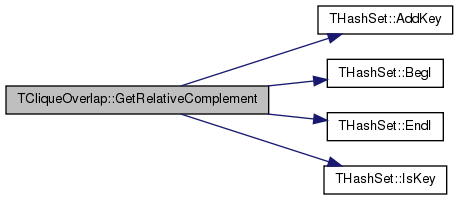

| int TCliqueOverlap::Intersection | ( | const THashSet< TInt > & | A, |
| const THashSet< TInt > & | B | ||
| ) | [static] |
Definition at line 23 of file cliques.cpp.
References THashSet< TKey, THashFunc >::BegI(), THashSet< TKey, THashFunc >::EndI(), THashSet< TKey, THashFunc >::IsKey(), and THashSet< TKey, THashFunc >::Len().
Referenced by CalculateOverlapMtx().
{
int n = 0;
if (A.Len() < B.Len()) {
for (THashSetKeyI<TInt> it=A.BegI(); it<A.EndI(); it++)
if (B.IsKey(it.GetKey())) n++;
} else {
for (THashSetKeyI<TInt> it=B.BegI(); it<B.EndI(); it++)
if (A.IsKey(it.GetKey())) n++;
}
return n;
}


| int TCliqueOverlap::MaxNbrsInCANDNodeId | ( | const THashSet< TInt > & | SUBG, |
| const THashSet< TInt > & | CAND | ||
| ) | const [private] |
Definition at line 53 of file cliques.cpp.
References THashSet< TKey, THashFunc >::BegI(), THashSet< TKey, THashFunc >::EndI(), TUNGraph::TNodeI::GetDeg(), TUNGraph::TNodeI::GetNbrNId(), TUNGraph::GetNI(), THashSet< TKey, THashFunc >::IsKey(), and m_G.
Referenced by Expand().
{
int id = -1;
int maxIntersection = -1;
//
for (THashSetKeyI<TInt> it=SUBG.BegI(); it<SUBG.EndI(); it++) {
int nId = it.GetKey();
TUNGraph::TNodeI nIt = m_G->GetNI(nId);
int deg = nIt.GetDeg();
//
int curIntersection = 0;
for (int i=0; i<deg; i++) {
int nbrId = nIt.GetNbrNId(i);
if (CAND.IsKey(nbrId)) curIntersection++;
}
//
if (maxIntersection < curIntersection) { maxIntersection=curIntersection; id=nId; }
}
return id;
}


PUNGraph TCliqueOverlap::m_G [private] |
Definition at line 10 of file cliques.h.
Referenced by GetMaximalCliques(), GetNbrs(), GetNodeIdWithMaxDeg(), and MaxNbrsInCANDNodeId().
TVec<TIntV>* TCliqueOverlap::m_maxCliques [private] |
Definition at line 12 of file cliques.h.
Referenced by Expand(), and GetMaximalCliques().
int TCliqueOverlap::m_minMaxCliqueSize [private] |
Definition at line 13 of file cliques.h.
Referenced by Expand(), and GetMaximalCliques().
TIntV TCliqueOverlap::m_Q [private] |
Definition at line 11 of file cliques.h.
Referenced by Expand(), and GetMaximalCliques().